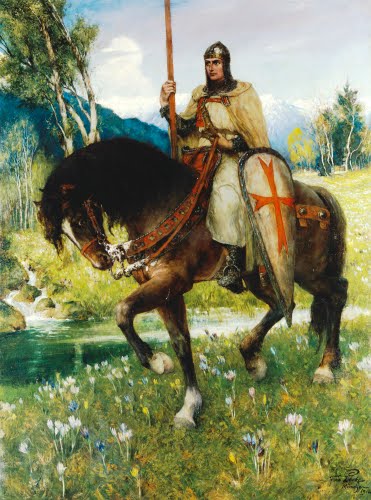Sunday, January 31, 2010
Sunday, January 24, 2010
Sahasrara (Ymirsday)
If we remove that glasslike barrier of which Ramakrishna spoke, ['It is like the light of a lamp inside a glass case. One feels as if one could touch the light, but the glass intervenes and prevents it.' ] both our God and ourselves will explode then into light, sheer light, one light , beyond names and forms, beyond thought and experience, beyond even the concepts "being" and "non-being." "The soul in God," Eckhart has said, "has naught in common with naught and is naught to aught." And again: "There is something in the soul so nearly kin to God that it is one and not united."The Sanskrit term Nirguna Brahman, "The Unqualified Absolute," refers to the realization of this chakra. Its lotus, Sahasrara, "Thousand Petalled," hangs head downward, shedding nectarous rays more lustrous than the moon; while at its center, brilliant as a lighting flash, is the ultimate yoni-triangle, within which, well concealed and very difficult to approach, is the great shining void in secret served by all gods. "Any flea as it is in God," declared Eckhart, "is nobler than the highest of the angels in himself."
Saturday, January 23, 2010
Ajna (Odinsday)
When the tasks of the fifth chakra have been accomplished, two degrees of illumination become available to the perfected saint, that at the sixth, known as savikalpa samadhi, "conditioned rapture," and finally, supremely, at the seventh chakra, nirvikalpa samadhi, "unconditioned rapture." Ramakrishna used to ask those approaching him for instruction: "Do you like to speak of God with form or without?" And we have words of the great doctor ecstaticus Meister Eckhart, referring to the passage from six to seven: "Man's last and highest leave-taking is the leaving of God for God."The center of the the first of these ecstasies, know as the lotus of "Command," Ajna, is above and between the brows. The uraeus serpent in Egyptian portraits of the pharaohs appears exactly as though from this point of the forehead. The center is described as a lotus of two pure white petals, bearing the syllables ham and ksham. Seated on a white lotus near its heart is the radiant six-headed goddess Hakini, holding in four of her six hands a book, a drum, a rosary, and a skull, while the remaining two make the "fear-dispelling" and "boon-bestowing" signs. Within the yoni triangle is a Shiva Lingam, shining "like a chain of lighting flashes," supporting the sign of the syllable OM, of which the sound is here fully heard. And here, too, the form is seen of one's ultimate vision of God, which is called in Sanskrit Saguna Brahman, "The Qualified Absolute."When the mind reaches this plane, one witnesses divine revelations day and night. Yet even then there remains a slight consciousness of "I." Having seen the unique manifestation man becomes mad with joy as it were and wishes to be one with the all-pervading Divine, but cannot do so. It is like the light of a lamp inside a glass case. One feels as if one could touch the light, but the glass intervenes and prevents it.
Thursday, January 21, 2010
Vishuddha (Thorsday)
I need to break in here and point out how special and exiting this post is for me. For a quick recap of what I've been doing, I've begun making an association built upon our primary sevens, such as the seven lotus centers (chakras), the days of the week, the seven notes in the western diatonic music scale, & the important heavenly bodies/western deities. With that in mind, I started climbing the chakras combining the associations with the help of Joseph Campbell's explanations of the lotus centers. So then, why is the post exciting?Once the great mystery-sound has been heard, the whole desire of the heart will be to learn to know it more fully, to hear it, not through things and within during certain fortunate moments only, but immediately and forever. And the attainment of this end will be the project of the next chakra, the fifth, which is at the level of larynx and is called Vishuddha, "Purified." "When the Kundalini reaches this plane," said Ramakrishna, "the devotee longs to talk and to hear only of God."The lotus has sixteen petals of a smoky purple hue, on each of which is engraved one of the sixteen Sanskrit vowels. In the middle of its pure white central triangle is a white disk, the full moon, wherein the syllable ham, of the element space of ether, rests on the back of a pure white elephant. The patron of this center is Shiva in his hermaproditic form know as Ardhanareshvara, "Half-Woman Lord," five-faced, clothed in a tiger's skin, and with ten radiant arms. One hand makes a "fear-dispelling" gesture and the rest are exhibiting his trident, battle-ax, sword, and thunderbolt, a fire, a snake-ring, a bell, a goad, and a noose, while beside him his goddess, here called Sakini, holds in her own four hands a bow, an arrow, a noose, and a goad. "This region," we are told in a Tantric text, "is the gateway of the Great Liberation." It is the place variously respresented in the myths and legends of the world as a threshold where the frightening Gate Guardians stand, the Sirens sing, the Clashing Rocks come together, and a ferry sets forth to the Land of No Return, the Land Below Waves, the Land of Eternal Yourth. However, as told in the Katha Upanishad: "It is the sharpened edge of a razor, hard to traverse." ~The Mythic Image Joseph CampbellShiva Ardhanari, "Half-Woman Lord."
Wednesday, January 20, 2010
Anahata (Heartsday)
And so we ascend to chakra four, at the level of the heart, where what Dante called La Vita Nuova, "The New Life," begins. And the name of this center is Anahata, "Not Struck"; for it is the place where the sound is heard "that is not made by any two things striking together."Every sound normally heard is of two things striking together; that of the voice for example, being the sound of the breath striking our vocal cords. The only sound not so made is that of the creative energy of the universe, the hum, so to speak, of the void, which is antecedent to things, and of which things are precipitations. this, they say, is heard as from within, within oneself and simultaneously within space. It is the sound beyond silence, heard as OM (very deeply intoned, I am told, somewhere about C below low C ). "The word OM," said Ramakrishna to his friends, "is Brahman. Following the trail of OM, one attains to Brahman."In the Sanskrit Devanagari script OM is written either as ॐ or as ओ , and in the posture of the dancing Shiva image the pose of the head, hands, and lifted foot suggests the outline of this sign--which makes the point that in the appearance of this god the sound resounds of the wonder of existence.The sound AUM, the, "not made by any two things striking together," and floating as it were in a setting of silence, is the seed sound of creation heard when the rising Kundalini reaches the level of the heart. For there, as they say, the Great Self abides and portals open to the void. The lotus of twelve red petals, marked with the syllables kam, kham, gam gham, ngam, cham, chham, jam, jham, nyam , tam, and tham, is of the element air. In its bright red center is an interlocking double triangle, the color of smoke, signifying "juncture" and containing its seed syllable yam displayed over an antelope, which is the beast, swift as wind, of the Vedic wind-god Vayu. The female triangle within this letter holds a lingam like shining gold, and the patron Hindu deity is Shiva in a gentle, boon-bestowing aspect. His shakti, known here as Kakini, lifts a noose and skull in two hands, while exhibiting with her other two the "boon-bestowing" and "fear-dispelling" gestures. ~Joseph Campbell The Mythic Image
Just below this lotus of the heart there is pictured a lesser [octagonal], uninscribed lotus, at about the level of the solar plexus, supporting on a jeweled altar an image of the Wish-Fulfilling Tree. For it is here that the first intimations are heard of the sound OM in the Silence, and that sound itself is the Wish-Fulfilling Tree. Once heard, it can be rediscovered everywhere and no longer do we have to seek our good. It is here-within-and through all things, all space. We can now give up our struggle for achievement, for love and power and the good, and may rest in peace.~Joseph Campbell The Mythic Image
Tuesday, January 19, 2010
Manipura (Tiwsday)
Chakra three, at the level of the navel, is called Maipura, "City of the Shining Jewel," for its fiery heat and light. Here the energy turns to violence and its aim is to consume, to master, to turn the world into oneself and one's own. The appropriated occidental psychology would be the Adlerian of the "will to power"; for now even sex becomes an occasion, not of erotic experience, but of achievement, conquest, self-reassurance, and frequently, also revenge. The lotus has ten petals, dark as thunderheads heavy laden, bearing the seed syllables dam, dham, nam, tam, tham, dam, dham, nam, pam, and pham. Its central triangle, in a white field, is the sign of the element fire, shining like the rising sun, with swastika marks on its sides. The ram, its symbolic animal, is the vehicle of Agni, Vedic god of the scrificial fire, bearing on its back the syllable ram, which is the seed syllable or sound form of this god and his fiery element. The presiding Hindu (as distinct from Vedic) deity is Shiva in his terrible guise as an ascetic smeared with the ashes of funeral pyres, seated on his white bull Nandi. And at this side is his goddess shakti, enthroned on a ruby lotus in her hideous character of Lakini. Lakini is blue, with three faces, three eyes to each; fierce of aspect, with protruding teeth. She is fond of meat; her breast is smeared with grease and blood that have dripped from her ravenous jaws; yet she is radiant, elegant with ornaments, and exalted from the drinking of ambrosia. She is the goddess who presides over all rites of human sacrifice and over the battlefields of mankind, terrible as death to behold, though to her devotees gracious, beautiful, and sweet as life.~ Joseph Campbell The Mythic Image
These, and these alone [the first three chakras], have supplied the motivations of historical man, his effective moral systems, and his nightmare of world history. They are the centers of the basic urges, furthermore, that mankind shares with the beasts -- namely, (1) to survive alive by feeding on other lives, (2) to generate offspring, and (3) to conquer and subdue. Unrestrained by any control system, these become devastating, as the history of the present century surely tells. For as declared in the IndianArthasastra, "Textbook on the Art of Winning": "When uncontrolled by virtue (dharma) and the big stick (danda), men become wolves unto men." The Inner Reaches of Outer Space, pg. 63-64 by Joseph Campbell, St. James Press, Toronto, 1986.
Now all three of these lower chakras are of the modes of man's living in the world in his naïve state, outward turned: the modes of the lovers, the fighters, the builders, the accomplishers. Joys and sorrows on these levels are functions of achievements in the world "out there" : what people think of one, what has been gained, what lost. And throughout the history of our species, people functioning only on these levels (who, of course, have been in the majority) have had to be tamed and brought to heel through the inculcation of a controlling sense of social duty and shared social values, enforced not only by secular authority but also by all those grandiose myths of an unchallengeable divine authority to which every social order--each in its own way--has had to lay claim. Wherever motivations of these kinds are not checked effectively, men, as the old texts say, "become wolves unto men."However, it is obvious that a religion operating only on these levels, having little or nothing to do with the fostering of inward, mystical realizations, would hardly merit the name of religion at all. It would be little more than an adjunct to police authority, offering in addition to ethical rules and advice intangible consolations for life's losses and a promise of future rewards for social duties fulfilled. Hence, to interpret the imagery, powers, and values of the higher chakras in terms of the values of these lower systems is to mistranslate them miserably, and to lose contact in oneself, thereby, with the whole history and heritage of mankind's life in the spirt.~Joseph Campbell The Mythic Image
Friday, January 15, 2010
Svadhishthana (Freyasday)
The second lotus of the series, called Svadhisthana, "Her Special Abode," is at the level of the genitals. (See fig. 313.) It is a vermilion lotus of six petals, bearing the syllables bam, bham, mam, yam, ram, and lam. Water being the element of this center, its inner field is the shape of a crescent moon, within which a mythological water monster known as a makara is to be seen, supporting the sign of the water syllable van. This is the seed sound of the Vedic god Varuna, lord of the rhythmic order of the universe. The presiding Hindu (as distinct from early Vedic) deity here is Vishnu in the pride of early youth, clothed in yellow and holding a noose in his hand. Beside him sits a wrathful form of his shakti, Rakini by name, of the color of a blue lotus, bearing in her four hands a lotus, a drum, a sharp battle-ax, and a spear, her teeth showing fiercely, her three eyes blazing red, and her mind exalted from the drinking of ambrosia. 11
When the Kundalini is active at this level, the whole aim of life is in sex. Not only is every thought and act sexually motivated, either as a means toward sexual ends or as a compensating sublimation of frustrated sexual zeal, but everything seen and heard is interpreted compulsively, both consciously and unconsciously, as symbolic of sexual themes. Psychic energy, that is to say, has the character here of the Freudian libido. Myths, deities, and religious rites are understood and experienced in sexual terms.
Now of course there are in fact a great many myths and rites directly addressed to the concerns of this important center of life—fertility rites, marriage rites, orgiastic festivals, and so on—and a Freudian approach to the reading and explanation of these may not be altogether inappropriate. However, according to Tantric learning, even though the obsession of the life-energies functioning from this psychological center is sexual, sexuality is not the primal ground, end, or even sole motivation of life. Any fixation at this level is consequently pathological. Everything then reminds the blocked and tortured victim of sex. But if it also reminds his doctor of sex, what is the likelihood of a cure? The method of the Kundalini is rather to recognize affirmatively the force and importance of this center and let the energies pass on through it, to become naturally transformed to other aims at the higher centers of the "rich in happiness" sushumna.~Joseph Campbell The Mythic Image
Monday, January 11, 2010
Muladhara (Lokisday)
The lotus at the base of the sushumna, called the "Root Support" (Muladhara), is described as crimson in hue and having four petals, on each of which a Sanskrit syllable is inscribed (reading clockwise, from the upper right: vam,´sam, sham, and sam). (See fig. 312.) These are to be understood as sound-counterparts of the aspects of spiritual energy operative on this plane. In the white center is a yellow square symbolic of the element earth, wherein a white elephant stands waving seven trunks. This animal is Airavata, the mythic vehicle of Indra, the Vedic king of the gods, here supporting on its back the sign of the syllable lam, "which," Woodroffe writes, "is said to be the expression in gross sound of the subtle sound made by the vibration of forces of this center." 9 The elephant, he continues, is symbolic of the strength, firmness, and solidity of earth; but it is also a cloud condemned to walk upon the earth, so that if it could be released from this condition it would rise. The supervising deity made visible in this lowest center is the world-creator Brahma, whose shakti, the goddess Savitri, is a personification of solar light. On the elephant's back is a downward-pointing triangle symbolic of the womb (yoni) of the goddess-mother of the universe, and within this "city of three sides," this "figure of desire," is seen the first or basal divine phallus (lingam) of the universal masculine principle, Shiva. The white serpent-goddess Kundalini, "fine as the fiber of a lotus-stalk," is coiled three and a half times around this lingam, asleep, and covering with her head its Brahma-door. 10
Now to be exact, the precise locus of this center at the base of the human body is midway between the anus and the genitals, and the character of the spiritual energy at that point is of the lowest intensity. The world view is of uninspired materialism, governed by "hard facts"; the art, sentimental naturalism; and the psychology, adequately described in behavioristic terms, is reactive, not active. There is on this plane no zeal for life, no explicit impulse to expand. There is simply a lethargic avidity in hanging on to existence; and it is this grim grip that must finally be broken, so that the spirit may be quit of its dull zeal simply to be.
One may think of the Kundalini on this level as comparable to a dragon; for dragons, we are told by those who know, have a propensity to hoard and guard things; and their favorite things to hoard and guard are jewels and beautiful young girls. They are unable to make use of either, but just hang on, and so the values in their treasury are unrealized, lost to themselves and to the world. On this level, the serpent-queen Kundalini is held captive by her own dragon-lethargy. She neither knows nor can communicate to the life that she controls any joy; yet will not relax her hold and let go. Her key motto is a stubborn "Here I am, and here I stay."
The first task of the yogi, then, must be to break at this level the cold dragon grip of his own spiritual lethargy and release the jewel-maid, his own shakti, for ascent to those higher spheres where she will become his spiritual teacher and guide to the bliss of an immortal life beyond sleep.~Joseph Campbell The Mythic Image
Friday, January 1, 2010
quantumsync
Heal The King!



































































